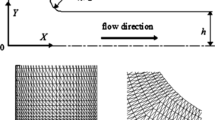Conclusions
Quantitative dependences have been obtained for pressure gradients, viscosities, and position of the liquid interface as functions of the flow rates of materials in two-layer axially symmetric flow.
It has been found that a decisive factor in change in coordinate of the liquid interfacial boundary in stratified flow is the ratio of the polymer viscosities.
The conditions under which the pressure gradient of the pair being extruded will be greater than the pressure gradients of the extruded components individually have been determined quantitatively.
Conditions under which the velocity profile under established flow will have the form of a “smooth” parabola, which answers the requirements for a stable position of the phase interfacial boundary, have been determined quantitatively.
Similar content being viewed by others
Literature cited
V. A. Anufriev, Yu. E. Lukach, et al., Gidrav. Gidrotekh., No. 24, 85–90 (1977).
H. V. Chin, Y. Kim, and C. D. Han, Polymer Eng. Rev., 4, No. 4, 281–311 (1984).
C. D. Han, Y. J. Kim, and H. B. Chin, Polymer Eng. Sci., 4, No. 3, 177–300 (1984).
Ch. É. Khan, Rheology in Processes of Polymer Processing [in Russian], Khimiya, Moscow (1979).
Additional information
Translated from Khimicheskie Volokna, No. 3, pp. 38–40, May–June, 1989.
Rights and permissions
About this article
Cite this article
Davydov, A.R., Pervadchuk, V.P., Trufanova, N.M. et al. Two-layer flow of polystyrene and polymethyl methacrylate melts in a cylindrical channel during coextrusion. Fibre Chem 21, 230–233 (1990). https://doi.org/10.1007/BF00549654
Received:
Issue Date:
DOI: https://doi.org/10.1007/BF00549654



